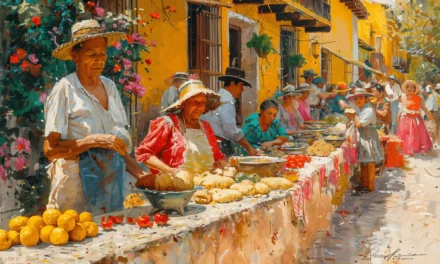Natilla is something to rejoice about if you’re from Colombia! It’s like a party in a bowl – a super tasty custard made with milk and eggs that’ll make your taste buds do a happy dance. Originating from Spain, natilla has embraced its Colombian flavors and laced them into a dessert that packs a sweet punch. Especially around the holidays, this traditional dessert is enjoyed by Colombian folks everywhere.
In Colombia, it’s like they took a classic recipe and gave it a special spin! It’s almost like the “natilla” recipe was the starting point for a great remix. During the colonial period, the ingredients were switched to create a unique blend of cornmeal, milk, a sweetener like sugar or panela, and sweet spice. It’s like the culinary magic trick Colombians have perfected: they’ve managed to create something that appears like a sumptuous custard without using any eggs.
In Colombia, the traditional natilla recipe has certainly had its fair share of changes over the years. Think of it like an old recipe handed down from grandparent to grandchild, and each time it’s passed down, a new generation brings its own flair and creativity.
Experimenting with Natilla: The Degustation Begins
It’s uncertain when the recipe first made its culinary debut, but the ingredients have been around since the seventeenth century, so it’s been kicking around for centuries! Spanish settlers tried to recreate the original Spanish dessert.
Natilla has definitely been adopted into local communities! Its popularity has spread like wildfire, and these communities can’t get enough of this delicious and creamy dessert. People are adding their own secret ingredients to their Natilla recipes, and it’s like they can’t help but try to outdo one another with their concoctions! So, don’t be surprised if you find Natilla being prepared in many different ways.
In the Colombian South Pacific Region, some local communities have found a way to tantalize even the sweetest of sweet tooths – they’ve been crafting up a delectable dessert that’s a treat for the taste buds. Imagine a cinnamon-infused bliss, with a velvety combination of sweet plantain, milk or coconut milk, and a sweetener like sugar or panela.
Christmas Traditions and Natilla from Antioquia
Sure, all the regions in Colombia had their own way of cooking up natilla, but it was in the beautiful region of Antioquia that the tasty aromas of its signature recipe truly mingled into one delicious dish.
By the XVIII century and during the XIX, it was very common to find references related to “natilla” for Christmas.
Natilla is like liquid gold for the people of Antioquia! It’s the crowning jewel of the dinner table, the sweet essence of holidays, and a delectable treat for many special occasions.
In Antioquia, it’s tradition to prepare a feast for Novena, and it’s the time to bust out the best pig your family could raise or afford. It’s like the Thanksgiving turkey, except its pig and way tastier! And when it comes down to the banquet, you know your family has been building up to this moment because it’s the pig you’ve been feeding and cleaning for months, making sure it’s the fattest, most flavorful one for your guests.

In the 19th and 20th centuries, Antioquia gifted the rest of the country with a special party favor – their unique customs and culture. Their delicious dishes and customs spread across Colombia like wildfire, making them one of the hottest culinary exports around. Not least, the prized recipe for Natilla.
Tasteful Treasures: Unearthing the Classic Natilla Recipe
Today’s Natilla recipe takes a drastically different form than it did in days gone by. Rather than grinding and straining corn (which would undoubtedly take ages), now most recipes call for corn starch, making this dessert a super simple and delicious treat.
Today the original recipe can be found in some rural areas, like a hidden gem tucked away in an old jewelry box or with some chefs that decided to rescue the original recipe like a knight in shining armor coming to the aid of a damsel in distress.
Industrial Revolution: Unlocking the Sweet Secret of Natilla
Corn starch was a welcomed guest to the party that was in the country in 1933, complete with a grand entrance made by big brands like Maizena, who brought the party to life. Pouring this new ingredient into recipes. The industrial revolution was like a ray of sunshine on a cloudy day for Antioquia and Colombia alike. People suddenly had access to oodles of products that made life a little bit easier.
Many factories have been bustling with activity, working hard to process, mill, and extract the starch from corn kernels. This makes it so much easier for people in the cities to stock up on corn starch and make a batch of delicious natilla. It was like the stars aligned, and corn starch became the go-to choice for natilla by the second half of the 20th century.
Natilla, as a modern symbol for Christmas, has been an inseparable part of the season since it was adopted around the 1970s. Natilla had become a modern symbol of Christmas cheer when local advertisers touted its delicious cornstarch/natilla mix for the holiday season.
While other countries can enjoy natilla or similar desserts all year round, in Colombia, it’s a bit of a treat and is mainly seen during certain seasons. It may not be a year-round treat like in other countries, but it’s certainly worth the wait. After all, natilla is the ultimate comfort food, and nothing compares to its deliciousness.




